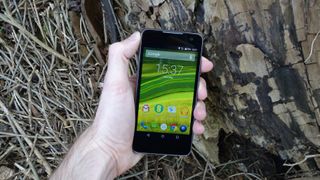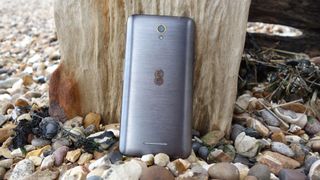TechRadar Verdict
Wi-Fi calling and stock Android Lollipop for £100 is an appealing package, but the EE Harrier Mini isn't quite a consistent enough performer to fully meet our newly raised expectations.
Pros
- +
Compact design
- +
Low price
- +
Easy Wi-Fi calling
Cons
- -
Build could be better
- -
Low internal storage
- -
Performance issues
Why you can trust TechRadar
With its £99 price tag and sub-5-inch display, the EE Harrier Mini is clearly the direct successor to last year's EE Kestrel. But has the market for affordable, respectably built 4G phones moved on too much for the UK network's new phone to wow in the same way?
If you cast your mind back to early 2014, access to the UK's emerging 4G networks was reserved for high-end phones with premium specs and price points. EE changed all of that with the EE Kestrel.
Here was a phone that provided blistering broadband-like data speeds over your mobile network (if you lived in a major town or city, at least) for a fifth of the price of an iPhone 5S.
The subsequent launch of the second generation Moto G and Moto E, plus a whole bunch of cheap Lumias, has all but obliterated the Kestrel's unique selling point – and these rivals offer superior hardware to boot.
The EE Harrier Mini looks to restore the UK network's advantage with some notably improved specs, all for the same low price.
Design
The EE Harrier is a completely different machine to the EE Kestrel, something that's evident from the moment you first open that bright yellow box and hold the device in your hand.
At 138 x 67.9 x 9.5mm, it sits in the hand nicely, and it's not too heavy at 124g. Coming straight from a Sony Xperia Z3 Compact, which has a similar-sized screen, it felt flabbier yet flimsier and a lot less solid. But then, that's no disgrace against one of the best-built phones out there – and one that costs three or four times the money.

From the front, the Harrier Mini is a pleasingly blank slate of almost Nexus proportions, with plain black bezels and an all-glass frontage. There are no capacitive buttons this time, with the three main Android controls handled in the OS itself.
This serves to reduce the size of the Harrier Mini's bezels compared to the EE Kestrel, but it's a shame the manufacturer, Ben-Q, didn't go further. Such are the constraints of building a modern phone to an extreme budget, I suppose.
From the back it's a very different story, with a slightly shiny, brushed metal effect cover that puts me in mind of the HTC One M9. That's dispelled as soon as you touch it, of course, as it's pure plastic.

This slightly chintzy feel continues with the mirrored EE symbol and a slightly gaudy yellowy-gold camera surround.
A final point to make on the rear of the Harrier Mini is its speaker placement. Sitting on the back of the phone is hardly ideal for clarity as it is, but its position towards the bottom also makes it all too easy to cover the speaker with your hand.

The physical side buttons are simple plastic affairs that are a little too spongy and wobbly, but the main issue with them is that they're oddly positioned. We've all grown accustomed to having both power and volume controls on the right edge of our phones, but here the power button has been relocated to the left edge.
It's perfectly reachable, but it might require a surprisingly lengthy relearning process before reaching for the power becomes instinctual. I found that this irritation was exacerbated by the lack of a double-tap to wake function in the Harrier Mini's software.
All in all, the Harrier Mini lacks the restrained classiness and premium feel of Motorola's budget handsets, but at least it's distinctive.

Arguably the biggest and most obvious improvement over the EE Kestrel is the EE Harrier Mini's display. It's both bigger and sharper, with the older phone's 4.5-inch qHD (that's quarter high definition, or 960 x 540) screen replaced by a 4.7-inch 1,280 x 720 example.
No, it's not the Full HD display of the larger EE Harrier, but 720p is more than adequate for screens of this size. The aforementioned Sony Xperia Z3 Compact has the same resolution, while even the iPhone 6 isn't far off.
Basically, the EE Harrier Mini's screen is plenty sharp enough, and we're glad to see such a resolution appearing in the entry-level market.

Unfortunately, though, resolution isn't the whole story when it comes to producing crisp images. The picture appears washed out and even a little murky and grainy, while colours lack the pop and contrast of handsets just slightly further up the cost chain (such as the Moto G).
Still, as budget smartphones go, the EE Harrier Mini's display is pretty decent.

